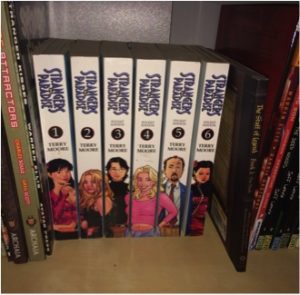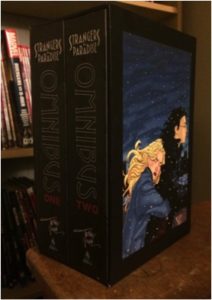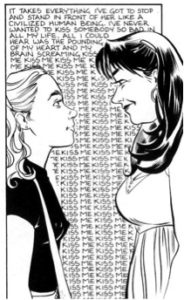I didn’t read Strangers in Paradise when it was being published as single issues. By the time I really got into comics, the series was already wrapping up a fourteen-year run. It was already a classic. It had been, for a long time, one of the books that I planned on eventually diving into – the length, as well as how highly it was regarded, was as intimidating as it was attractive. It was early last year that I found myself enthralled with another series by SiP author Terry Moore. This one was called Rachel Rising, and it’s a quiet, sharp, whip-smart horror story about a dead girl rising from the dirt and trying to pick up with her life where she left off. I fell deeply in love with the characters in the world Moore was building, but fewer than twenty-five issues had been released at that point. Suddenly, the six volumes of Strangers in Paradise that sat untouched on my shelf looked less like a upwards climb and more like solace.
Solace is a good word for Strangers in Paradise. A funny one, too, considering how many times the series pulled the rug out from under my feet and broke my heart. But that’s the thing about SiP – when you meet Katchoo and Francine, two best friends from completely different lives, you think you’re being introduced to funny, quirky characters that you can get behind and root for… which you are. Without warning though, for me at least, and certainly the people I’ve introduced this series to, it become more than that. See, Strangers in Paradise didn’t worm its way into my heart, slowly making me care. The book, somewhere around the middle of the first volume, Casey Femur’d me. Casey is one of the leads: a cheery, perpetually excited, loveable, cosmetically enhanced woman who is introduced to the group after marrying Francine’s ex, Freddie. Casey eventually becomes very close to all of the main characters and has a penchant for running at them, and nearly flattening them with a surprise hug. Completely throwing herself at the object of her affection, making damn sure that they know how much she loves them, and that they better love her back. Strangers in Paradise did that to me… and the depth of my love for the characters grew with each volume.
At the center of Strangers are Katchoo and Francine, and their on again/off again relationship. They’re friends, but Katchoo loves Francine, but Francine begins to suspect Katchoo is in love with an idealized version of her that she can’t live up to, but Katchoo needs Francine, but Francine thinks about it, but wait, no, Francine refuses to let go of her dream of marrying a handsome man and spoiling her children… and so on. Their story, as well as the story of David, a man from Katchoo’s past who becomes the only man in whom Katchoo can confide, unfolds much like life. Instead of the big, sweeping, Earth-shattering moments, Terry Moore shows us everything. We see the quiet moments of their lives – and not just Francine and Katchoo’s. We see into the home life of the police officer investigating Katchoo as he uncovers the truth of her past life. We watch Casey’s face break as Katchoo’s words sting. We see Freddie Femur scheming to get a sexy picture of Francine from his buddy. We peek into the life of Pia, the young anorexic girl ringing up Katchoo at the art supply store. We, along with the characters, become fans of Griffin Silver, a musician within the world of SiP that feels as real to me as anyone on my iTunes playlist. We spend enough time with Francine, Katchoo, David, Casey, and the inscrutable Tambi to not only understand why they love each other, but to feel the depth of it and to return it in kind.
I just finished Strangers in Paradise. The final image is still in my head. I can still see the snowflakes falling, and then a door closing on the characters, letting us know that they are going on even though we’re leaving them to continue their journey. It’s difficult to formulate a coherent thought about such a staggering work from inarguably one of the greatest artists working in the graphic medium. But yet, having finished Strangers, I’m thinking about the recent forward movement in the industry. Not only independent comics, but also books from Marvel and DC, such as Ms. Marvel and Batgirl, are pushing the comics industry forward. Comics were once rife with the singular idea of the white male hero and were rife with erasure and non-representation, but the graphic medium is now becoming one of the most inclusive art forms, as LGBT* presence and representation of people of color becomes more than just an afterthought. It is a great time to be part of the comics industry, and to be someone who loves comics. And, with the context of how far the industry has come to get here, Strangers in Paradise stands out as a unicorn from its time. SiP is, from the very first issue which came out in the first month of 1993, unapologetically feminist, body positive, and LGBT-inclusive. The idea of “conventional love” (Francine’s dream – a heterosexual and monogamous marriage) is dissected and subverted, as the characters find themselves and explore what they want from life, lust, and love. Above all, the characters are written by Terry Moore with deep nuance and empathy – and god, does it show.
There’s so much to the world Terry Moore has built in Strangers in Paradise. And that’s just it – because it’s a world. In SiP, like in our world, no one is a side character and everyone has a story. And, until the next time I meet up with Francine and Katchoo – hopefully with that novel Terry promised, but if not that then my next re-read – I’m going to miss reading their stories, because to me, it didn’t feel much like reading at all. It felt like hanging out with my very best friends.
PAT SHAND is a comic book writer (Robyn Hood, Charmed: Season Ten, Grimm Fairy Tales: Arcane Acre) and pop culture journalist (Blastoff Comics, Sad Girls Guide). He wishes he could draw a beautifully as Terry Moore but, until then, stick figures will just have to do. You can find him at patrickshand.tumblr.com.





Comments are closed.